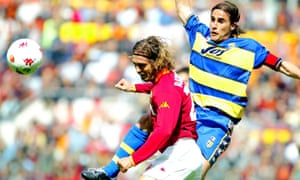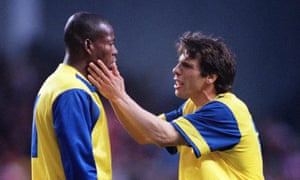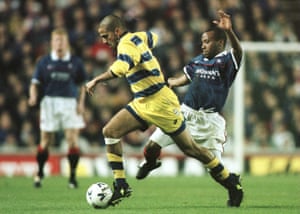Everybody remembers how it ended. From 1990 to 2004, Parma competed as one of Italy’s foremost teams, qualifying for Europe in 14 consecutive seasons and winning four pieces of continental silverware. Then their parent company and chief sponsor, Parmalat, collapsed amid one of the most staggering financial fraud scandals the world has ever known.
Parma avoided instant oblivion. Technically the club did fold, but a subtly renamed version sprung up in its place, taking over the contracts, debts and – crucially – Serie A status of its predecessor.
Still, the wax in Parma’s Icarus wings had started to melt. They did not compete for major honours in the decade that followed, sneaking into the Uefa Cup only once, in 2006, after Juventus, Fiorentina and Lazio were all docked points as a result of the Calciopoli scandal. In 2015, Parma went bankrupt. This time, they would have to start over from Serie D.
Their rapid return to the top flight, with three promotions in as many seasons, has been a sensational story. But the part of this tale that gets told less often is where it all began. Not with Parmalat, but with a man named Ernesto Ceresini, who became the club’s president in 1976.
Parma were playing in the third tier of Italian football – then known as Serie C – and had never been higher than the second. No more was expected for a team from a town of 200,000 people, where baseball, volleyball and cycling all competed for sports fans’ interest.
Ceresini, a local businessman who made his money in construction, is said to have bought into Parma almost as a means of distraction: seeking new purpose after his wife died. But his appointment of Arrigo Sacchi as manager in 1985 would be a turning point. The former shoe salesman had just secured promotion from Serie C for Rimini and took Parma up at the first attempt. He followed that up in his second season by beating Milan twice at San Siro in the Coppa Italia.

It was at the end of that campaign, with Sacchi on his way to Milan, that Parmalat got involved, becoming the club’s main sponsor and buying a small minority stake from Ceresini. The company was seen as an extraordinary success story – a local dairy operation that in just two decades had expanded into a global food conglomerate.
Parma were about to experience a similarly explosive rise. Sacchi was succeeded briefly by Zdenek Zeman and then Giampiero Vitali, before Ceresini identified Nevio Scala in 1989 as the man to take them to the promised land. “The first thing he said to me was that he had a dream,” the manager later recalled. “He wanted to see Parma in Serie A.”
Scala had narrowly failed to steer Reggina into the top flight that spring, finishing level on points with Cremonese in fourth but losing a promotion tie-breaker on penalties. He took Parma up at the first attempt. Devastatingly, that was still not soon enough for Ceresini, who died after a heart attack in February 1990.
At the time, Parma were in a slump. They had taken a single point from their first five games of the year, and Scala wondered if the owner’s death might spell the end of his tenure. “I remember a meeting in the changing room with [Ceresini’s son] Fulvio, who asked me if I wanted to carry on,” remembered Scala in an interview with the Gazzetta di Parma. “He was the president now and if he had any doubts, he could easily have fired me. Instead he thought about it, remembered everything we discussed with his father, and extended my contract. It had an impact on the players, who despite all the problems of that moment, understood something important was happening.”
Parma secured promotion with victory over local rivals Reggiana on the penultimate weekend, reaching Serie A for the first time. Even then they could not have imagined what lay ahead. Fulvio Ceresini sold most of his stake in the club to Parmalat, and the new owners splashed out on three players who had impressed in that summer’s World Cup in Italy: the Brazil goalkeeper Cláudio Taffarel, Belgium defender Georges Grün and a young Swede named Tomas Brolin.
In that first season of top-flight football Parma did not even have a fixed training location. The players travelled to the club’s Tardini stadium every morning and got changed in the dressing rooms before boarding a bus – sometimes it would take them to facilities owned by another club, sometimes to whatever patch of council-owned land could be found in their home town or a neighbouring village.

Perhaps that was a factor in their success. “It was a team that was born right there, that grew up in the middle of a public park,” said the defender Luigi Apolloni. “The whole city was involved together.”
The impact of Brolin was more objectively clear, a whirling dervish between the lines of midfield and attack in Scala’s 3-5-1-1. Brolin scored seven goals in that first season, all the more memorable for his leaping pirouette celebrations. But more than that he lent his team energy and joy. Parma played on the front foot, their wing-backs encouraged to go forward in a way that was unheard of in Serie A back then.
They finished sixth and followed up in 1991-92 by winning the Coppa Italia, beating Juventus in the final. Scala knew it could be another turning point. “We didn’t just win the Coppa Italia,” he told Corriere della Sera. “We pulled off our greatest coup. Our players have understood that you can win here, and other players saw it too. In future, they will not view us as a provincial club with an uncertain future.”
That summer Parma added Faustino Asprilla, whose goals helped propel them to a more unlikely achievement still: winning the Cup Winners’ Cup at the first time of asking in 1993. He scored four times in the competition, though ultimately wound up on the bench for the final against Royal Antwerp, with Brolin preferred in support of Alessandro Melli.
Looking back on the team that triumphed that day, it is striking how many of Parma’s starting XI were not recent additions. Melli, Apolloni, Marco Osio, Daniele Zoratto and the captain Lorenzo Minotti had all been with the club in Serie B. Minotti and Melli scored the first two of Parma’s goals in a 3-1 win. Parmalat’s money had played a part, but it was hardly the only ingredient.
If anything, it was that first European triumph that prompted the owners to really start throwing money around. Parma spent 20bn Italian lira to acquire Gianfranco Zola from Napoli and Nestor Sensini from Udinese. In 1994 they beat Milan to win the Uefa Super Cup and reached the Cup Winners’ Cup final again, this time losing to Arsenal.
On it went, this dizzying and implausible chapter. Parma had signed Dino Baggio from Juventus, and he scored a goal in each leg of the 1995 Uefa Cup final against his former club, securing a 2-1 aggregate win. In their first five seasons as a top-flight club, Scala’s team had claimed four major trophies.
Although the deluge of silverware dried up, new signings continued to pour in. Parma landed a Ballon d’Or winner, Hristo Stoichkov, together with Fabio Cannavaro and Pippo Inzaghi in 1995. A year later, Hernán Crespo, Lilian Thuram and Enrico Chiesa arrived. In 1998, along came Juan Sebastián Verón. An outlandishly confident young goalkeeper, Gigi Buffon, emerged from the academy.

The Parma team that won the Uefa Cup in 1999 might have boasted the most talented starting XI in Europe. Buffon in goal, Cannavaro, Thuram and Sensini at the back, Verón, Baggio and Alain Boghossian in midfield, Paolo Vanoli and Diego Fuser out wide and Crespo paired with Chiesa up front. They obliterated the competition, beating Bordeaux 7-2 on aggregate in the quarter-finals, Atlético Madrid 5-2 in the semis and Marseille 3-0 in the final.
That team, managed by Alberto Malesani (Scala had moved on in 1996), remains the last Serie A representative to win what is now the Europa League. Parma paired the success with another Coppa Italia triumph and would raise the latter trophy for a third time in 2002.
Then came Parmalat’s collapse, a scandal with wide-reaching human consequences. Thousands of employees all over the world lost their livelihoods, along with countless more who relied on their business. None of this was any fault of Parma’s footballing staff, yet their success is inescapably coloured by the knowledge that such a glorious team was assembled with money that did not exist. Perhaps that is why many Parma fans still hold most fondly to the memory of those earlier sides: to Melli, Minotti and Osio. And to Ernesto Ceresini, the owner whose dream became an extraordinary reality, too late for him to take part.
This February, shortly after the anniversary of his death, a banner was unfurled by supporters at Parma’s home game against Lazio. “Ceresini,” it read simply, “The eternal president.”
Source link






